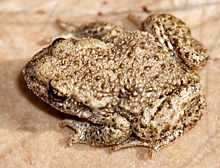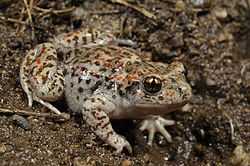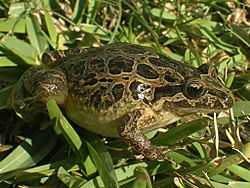Alytidae
| Discoglossidae Temporal range: Late Jurassic to Recent[1] | |
|---|---|
 | |
| Alytes obstetricans | |
| Scientific classification | |
| Kingdom: | Animalia |
| Phylum: | Chordata |
| Class: | Amphibia |
| Order: | Anura |
| Family: | Alytidae Fitzinger, 1843 |
| Genera | |
|
Genus Alytes | |
| | |
| Distribution of Discoglossidae (in black) | |
| Synonyms | |
|
Discoglossidae Günther, 1859 | |
The Alytidae are a family of primitive frogs.[2][3][4][5] Their common name is painted frogs[2] or midwife toads.[4] Most are endemic to Europe, but there are also three species in northwest Africa, and a species formerly thought to be extinct in Israel.
This family is also known as Discoglossidae, but the older name Alytidae has priority and is now recognized by major reference works.[2][3][4][5] However, some researchers suggest that Alytes and Discoglossus are different enough to be treated as separate families, implying resurrection of Discoglossidae.[2]
Genera and species
The family contains three extant genera, Alytes, Discoglossus, and Latonia. The first is somewhat toad-like and can often be found on land. The second is smoother and more frog-like, preferring the water.[6] The third genus was until recently considered extinct, and is represented by the recently rediscovered Hula painted frog. All of the species have pond-dwelling tadpoles.
The genera Bombina and Barbourula also used to be under this family, but have now been moved to the Bombinatoridae.[7]
Family Alytidae
- Genus Alytes
- Alytes cisternasii - Iberian midwife toad
- Alytes dickhilleni - southern midwife toad
- Alytes maurus - Moroccan midwife Toad
- Alytes muletensis - Majorcan midwife toad
- Alytes obstetricans - common midwife toad
- Genus Discoglossus
- Discoglossus galganoi - West Iberian painted frog
- Discoglossus jeanneae - Spanish painted frog
- Discoglossus montalentii - Corsican painted frog
- Discoglossus pictus - common painted frog
- Discoglossus sardus - Tyrrhenian painted frog
- Discoglossus scovazzi - Moroccan painted frog
- Genus Latonia
- Latonia nigriventer - Hula painted frog
- Genus †Enneabatrachus (prehistoric)[1]
- †Enneabatrachus hechti[1]
-

Iberian midwife toad (Alytes cisternasii)
-

Iberian or Portuguese painted frog (Discoglossus galganoi)
-

Fossil discoglossid from Miocene (†Latonia seyfriedi)
References
- ↑ 1.0 1.1 1.2 Foster, J. (2007). "Enneabatrachus hechti" Jurassic West: The Dinosaurs of the Morrison Formation and Their World. Indiana University Press. p. 137.
- ↑ 2.0 2.1 2.2 2.3 Frost, Darrel R. (2014). "Alytidae Fitzinger, 1843". Amphibian Species of the World: an Online Reference. Version 6.0. American Museum of Natural History. Retrieved 12 April 2014.
- ↑ 3.0 3.1 "Alytidae Fitzinger, 1843". Integrated Taxonomic Information System.
- ↑ 4.0 4.1 4.2 "Alytidae". AmphibiaWeb: Information on amphibian biology and conservation. [web application]. Berkeley, California: AmphibiaWeb. 2014. Retrieved 12 April 2014.
- ↑ 5.0 5.1 Blackburn, D.C.; Wake, D.B. (2011). "Class Amphibia Gray, 1825. In: Zhang, Z.-Q. (Ed.) Animal biodiversity: An outline of higher-level classification and survey of taxonomic richness" (PDF). Zootaxa 3148: 39–55.
- ↑ Zweifel, Richard G. (1998). Cogger, H.G. & Zweifel, R.G., ed. Encyclopedia of Reptiles and Amphibians. San Diego: Academic Press. pp. 85–86. ISBN 0-12-178560-2.
- ↑ Frost, Darrel R. (2014). "Bombinatoridae Gray, 1825". Amphibian Species of the World: an Online Reference. Version 6.0. American Museum of Natural History. Retrieved 12 April 2014.
- San Mauro, Diego; Garcia-Paris, Mario; Zardoya, Rafael (December 2004). "Phylogenetic relationships of discoglossid frogs (Amphibia:Anura:Discoglossidae) based on complete mitochondrial genomes and nuclear genes". Gene 343 (2): 357–366. doi:10.1016/j.gene.2004.10.001. PMID 15588590.
- San Mauro, Diego; Vences, Miguel; Alcobendas, Marina; Zardoya, Rafael; Meyer, Axel (May 2005). "Initial diversification of living amphibians predated the breakup of Pangaea" (– SCHOLAR SEARCH). American Naturalist 165 (5): 590–599. doi:10.1086/429523. PMID 15795855.
| |||||||||||||||||||||